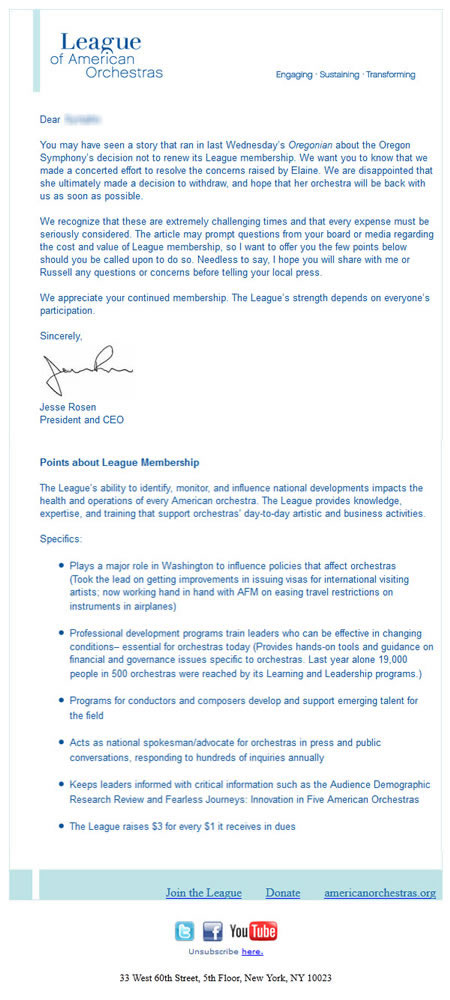The 1/4/2012 edition of The Oregonian published an article by David Stabler that examines the Oregon Symphony Orchestra’s (OSO) decision to cancel its membership in the League of American Orchestras (League). At the time this post was published, Stabler’s piece has picked up a good bit of social media juice with 107 Facebook recommendations and 59 tweets.
What makes Stabler’s article worth reading isn’t that it simply does a good job at reporting an event, but his overview of the unusual level of transparency related to the executive process that led to the OSO’s decision to leave the League.
To that end, OSO president Elaine Calder deserves a huge round of kudos for engaging Stabler on the topic and not opting for the easy way out with “no comment” or non-answer replies.
According to what Stabler reports, Calder summed up the decision as one motivated by a return on investment that fell short of expectations. In short, the orchestra identified better ways to use the $17,000 annual fee they paid in membership dues.
“I’ve suggested to the League that mid-sized orchestras like ours carry a disproportionate share of the League’s expenses, given the way the dues are structured.”
“Institutionally we are so tightly staffed that we couldn’t find the time to fill in some of the League’s massive surveys in the past few years – and to be honest, we didn’t find the data particularly useful when the results were released.”
“I’ve been to the midwinter managers’ meetings and some of the annual conferences and found the sessions slightly more relevant but somewhat less interesting…”
Then there was the focus on League activity. Calder sums up the organization’s frustration with “new model” discussions and related activity with laser-like poignancy.
“And I find the on-going discussion around the need for a “new model” dispiriting. All orchestras hire a lot of musicians on contract to perform symphonic concerts, and cover the expenses by selling tickets, raising money and building an endowment… Going to meetings and conferences can sometimes yield ideas and inspirations from one’s colleagues, but there’s a lot of ink or virtual ink these days on the business of running orchestras so I don’t think we’re falling behind.”
If you’re curious what $17,000 can do vis-a-vis non-artistic activity for an orchestra like the OSO [besides straightforward deficit reduction], here is a tiny representative example of how those funds could be used:
- …a completely redesigned website (with ample money to spare).
- …updated software licenses for basic productivity office suites.
- …improvements to the CRM database.
- …expanded customer service and box office capacity.
- …professional development for key staff members.
- …increased expense accounts for key members of the development team.
- …making sure the operation department’s vehicle(s) don’t miss regularly scheduled maintenance.
- …and much, much more.

I contacted Calder to see if there was anything else she wanted to add above and beyond what was publihsed in The Oregonian and she offered up the following comment about her interview with Stabler.
“David Stabler called me and said he’d heard we were thinking of leaving the League. I don’t know where he got this information and it doesn’t matter, so I told him we’d already made the decision and gave him some of our reasons. I cherish the fact that The Oregonian still gives David column inches to write about us. I rarely give him a “no comment” response and instead try to give him answers that he and his readers might find of interest – and help them to understand better how an organization like ours works. As I said in the article, I think we have to find solutions that are appropriate to our community, and being as open and honest as possible with stakeholders seems like a fundamental requirement.”
It will be interesting to see if any other professional orchestras follow the OSO’s lead and suspend their League membership. Even if an organization doesn’t arrive at a return on investment conclusion similar to what Calder described, it sometimes comes down to simply managing debt.
From that pragmatic perspective, temporarily suspending membership until the institution crosses specific revenue thresholds is precisely the sort of arrangement many orchestras have put into place via their collective bargaining agreements with regard to improvements to employee compensation. In the interim, executives, managers, and board members can purchase individual memberships at their own expense so that the organization’s stakeholders aren’t required to shoulder the expense.
Stabler’s article also includes a brief quote from League director of media relations, Rachelle Schlosser, who indicated that the service organization’s membership isn’t suffering.
“There is definitely not a trend among orchestras to drop League membership and none of the Oregon Symphony’s peers have done so. Renewals are occurring on an ongoing basis, and we fully expect to be at our traditional 850+ membership level.”
But I’m curious to hear first hand from organizations about this. Has your orchestra considered dropping your League membership or restricting League related expenses; if so, why?
Are the OSO’s actions and your own economic situation causing you to update your League membership’s return on investment? If so, what are your thoughts?
[sws_toggle1 title=”Update: 11:15am CT, 1/12/2012. Over the course of this morning, I’ve received dozens of email messages forwarding along a League memo addressing Stabler’s article. Click to see the memo.”]

[/sws_toggle1]



I have advised the board of my youth orchestra to drop our membership with the LAO. While the yearly fee of $150 isn’t very much, we can only point to one so-called benefit: we can place the LAO’s logo on our website and our programs. We certainly can make better use of that money, small amount or not. In addition, the LAO clogs our board and staff email boxes with material that is not relevant when we have the time to look at it, and mostly we don’t have the time as we work hard to fulfill our mission of training young musicians.
I also have an issue with a professional orchestra paying the kind of ridiculous annual dues that LAO membership requires. How is it that musicians who belong to an orchestra with a collective bargaining agreement have to agree to having dues collected from their own checks for AFM, ROPA and ICSOM, but management of the same orchestra do not have to go through the same process for membership in the LAO. Isn’t the LAO essentially a “management” union? I don’t feel that membership in the LAO should be on the backs of the orchestra and it’s musicians.
Last, until the LAO publicly distances itself from the “new model” as presented here in Denver by Bruce Clinton, I hope every orchestra in the nation cancels it’s membership in the LAO.
I think the party is over!
I can’t argue whether LAO membership dues may or may not be worthwhile for some groups, but it’s most definitely not true that the LAO is a “management union.” Unions negotiate with “owners” for employment conditions, benefits, and compensatory material on behalf of industry-wide subsets of specialized employees. LAO has no such activities.
Also, I’m no representative of LAO, but I believe they would argue that they exist to support “orchestras,” meaning the whole gamut: from musicians to management to industry vendors and others. I know several of our own musicians take active interest in engaging with other LAO musicians and consider our membership a valuable tool for interaction with peers in the industry.
I wouldn’t agree with everything LAO says, but it’s not their job to be “agreeable.” They are there to be a motivator and vehicle for community discussion, which we frankly need more of in this industry.
Semantics of defining what the LAO is aside (and I believe the evidence supports that it is at very least an unofficial “union” for management/boards), the LAO was no where to be seen in a supportive role when the Colorado Symphony was in trouble, unless you count Bruce Clinton and his agenda as LAO support. If that is LAO support, then it is proof that the LAO is an anti-musician, anti-labor organization. It’s hard to know if the LAO supports Clinton’s agenda or not, since the LAO refuses to clarify it’s position in regard to Clinton’s agenda here in Denver. In addition, during the depth this fall with the CSO, the LAO President Jesse Rosen was interviewed by our local public radio station, and his statements showed either a complete lack of understanding or blatant ignorance of the facts of the situation in Denver. Instead, it was the same old gloom and doom orchestras are in trouble blah blah blah. The CSO was in fact a sustainable organization until management and the board started skimming the profits of the CSO and putting them in an unnecessary building fund. So the LAO can’t be “a motivator and vehicle for community discussion” when they are either ignorant or have an agenda. It’s not about being agreeable, it’s about being responsible.
Tom, do you have a reference link to the radio interview you mentioned? Without providing that for readers to research on their own, it isn’t fair to characterize someone’s statements.
Thanks,
Drew
Hi Drew,
Here is the link to the interview with Jess Rosen. Thanks!
http://www.cpr.org/category/colorado_matters#load_article|CSOs_Financial_Struggles_Reflect_National_Trend
Many thanks Tom.
I don’t believe that it is the role of a service organization such as LAO or Opera America to “take positions” or to prop up, save, or otherwise become engaged in the inner workings of any one member organization’s operations. I have seen the LAO provide resources in the form of providing studies, hosting discussions, and opening doors with access to people and ideas with the intent of helping member organizations get better information from which to make informed decisions. Sometimes the LAO hits – and sometimes they miss, in my opinion.
I do know from my personal experience that the LAO has never been pro or anti union – some of the individual members of the LAO might have opinions or stances on such topics – but the LAO in my opinion has tried very hard to just “be there” to encourage new ideas, share success, and to a much lesser degree, share failure.
I would also add that I know many orchestra executives who do good work, are inclusive in their leadership styles, and strive to be top notch CEO’s. And I know of some orchestra execs who are less inclusive, deride musicians as problems, and try to fight their battles in a different manner.
Just like I know orchestra musicians who are terrific partners with their managements, lead their peers in a supportive and professional manner, and work to be part of the everyday solutions facing orchestras. And I know orchestra members who think management is only out to screw them over, and that their level of trust with management is about as far as they can spit.
So, I guess my message in this brief moment is that on all sides of the orchestra business, there are people of all stripes – just as there are across the globe in all walks of life. To paint them all with the same brush is usually the wrong thing to do, even though sometimes it feels good to do so.
I wonder if many stakeholders of the nation’s professional orchestras are aware of this outsized cost of membership? I have been working with orchestras in one way or another for over 20 years and was shocked at the $17,000 figure.
That’s a good question and I know the League uses a formula based on artistic expenses and total expenses to determine the rate but I don’t recall exactly what the formula is.
But after doing a quick Google search for “league of american orchestras membership dues” I found the following page at the League’s website which contains an online application form and calculator to determine dues: https://secure.americanorchestras.org/faxform.shtml (granted, a notice at the top of the form reads “For membership now through September 30, 2011”).
Something else to add here, notice toward the bottom of the form, in the footnotes that it appears the annual dues are capped around $29,000.
The footnote reads: “…times total expenses (in US $), up to $29,120 USA/up to US $6,850 for Canadian”
I believe this is what Elaine Calder is referencing in her comments to the Oregonian when she said “…mid-sized orchestras like ours carry a disproportionate share of the League’s expenses, given the way the dues are structured.”
It appears that the cut off point where overall and artistic expenditures no longer impact dues is approximately $25,000,000. A quick look at orchestra budgets reveals that between 15-20 ensembles exceed that cap, including LA, Boston, Chicago, New York, San Fran, Cleveland, Philly, Atlanta, Cincy, Indy, Detroit, Minnesota, Pittsburgh, Nashville, Dallas, Baltimore, and St. Louis (although the ones toward the end of the list might have dropped below the threshold after last season).
In the most extreme cases, the threshold saves some orchestras nearly three times what their dues would be if there were no cap.
I have been a professional member of the League since I stopped working for a member orchestra. I can’t speak to the benefits of membership to orchestras in general, but they have an incredibly helpful staff when you need any answers about visa processing and the information they provide about government issues in general saves me quite a bit of time. As long as they maintain these services, it is well worth the cost of my professional membership.
I know a number of folks in various orgs who speak highly of the visa assistance so it’s good to hear you have the same experience. But according to Calder (not to mention the flood of emails arriving today) it seems that the benefits aren’t rising high enough to justify the member orchestra dues. But it would certainly be interesting to find out the differences between services offered for pro and ensemble members and satisfaction rates.